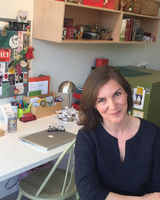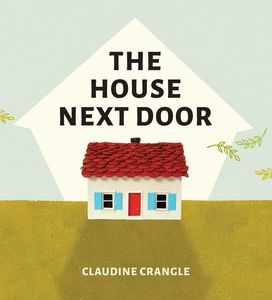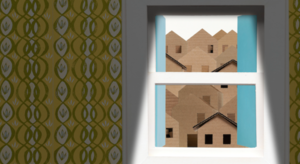Claudine Crangle's Fantastic, Wes Anderson-esque Artwork is a Perfect Backdrop to Her Story of How to Welcome Change
The more closely you look at the artwork Claudine Crangle creates for her children's books, the more amazed you will be. Her newest offering is The House Next Door (Groundwood Books), a gentle, witty tale of how change can be difficult but doesn't always have to be bad. Crangle's sweet fable follows the titular house as a character rather than a simple building: He's been alone as long as he can remember, and when other houses suddenly begin appearing around him, he can't help but be alarmed, even closing his shutters to try to shut out this strange new situation. Once he's brave enough to look around though, the house finds something entirely unexpected.
The artwork that accompanies this heart-warming story is wildly creative. A multimedia artist, Crangle uses cardboard, fabrics, paint, and more to create fascinating, Wes Anderson-esque storyscapes. Much of the material for this project was scavenged from local recycling bins near her Toronto home.
We're excited to welcome Claudine to Open Book today to participate in our Kids Club interview series. She tells us about the message she hopes kids will take from the house's story ("we get to decide how we will respond to change"), two of her favourite – and very different – favourite books for young readers, and the part of the writing and publishing process that she loves the most.
Open Book:
Tell us about your new book and how it came to be.
Claudine Crangle:
The House Next Door is the story of a little house that is pretty content with his lot, which is alone, on an empty farm field. Of course, it’s not without challenges – the wind, for example is constantly pushing up against him and making his shutters rattle. When some new houses show up, he’s not thrilled by the change of scenery, so he closes his shutters. When more arrive the only way to block them out is to shutter every window.
I grew up in Bramalea, Ontario, in the early 1970s when farm fields were transformed into subdivisions so fast that the neighbourhoods had names like “H Division”, where I lived. Bramalea was new and affordable and attracted many new Canadians, like my family.
At 12, we moved less than an hour away, to Oakville, which was still a pretty small town back in 1980. The first thing my brother and I noticed was that there were huge trees everywhere, and that everyone looked the same. Many of the houses around ours had historical plaques, and our neighbours took pride in keeping things “as they were”. I now see that this story has been percolating inside of me for a very long time.
OB:
Is there a message you hope kids might take away from reading your book?
CC:
Accepting change is not easy – at any age, but it is part of life, and part of what makes life so beautiful, rich and surprising. Usually that’s very hard to see at first.
For a kid, this change might be the arrival of a new sibling who is taking up too much attention, for example. Soon that baby will become a playmate, co-conspirator, and possibly one of the most beloved people in their life. Or not – but that baby is here and the world has changed. We can’t avoid change – it keeps coming. The message I hope kids will take away is that we are not powerless – we get to decide how we will respond to change.
Your CanLit News
Subscribe to Open Book’s newsletter to get local book events, literary content, writing tips, and more in your inbox
OB:
What do you need in order to write – in terms of space, food, rituals, writing instruments?
CC:
I’m incredibly lucky to have a dedicated, bright studio space in which to write and do artwork. It’s attached to our home, but you must walk across an exterior deck to get to it, and this transition helps with getting into a creative headspace.
That said, the studio is rarely where the initial ideas come from. I find that long car rides in the passenger seat are ideal for ideation. I never depart for a long trip without my notebook and pencil – where I scrawl bumpy notes and thoughts, and then stare out the window ruminating. Long train rides work too!
OB:
What defines a great book for young readers, in your opinion? Tell us about one or two books you consider to be truly great kids books, whether you read them as a child or an adult.
CC:
I have a lot of favourites, but two I’m thinking about are Hubert Horatio by Lauren Child and It’s a Secret by John Burningham. They are very different from each other, but each has a unique approach to a child’s viewpoint.
Hubert Horatio is a hilarious tale of a kid who needs to rescue his incredibly rich parents from ruin. My copy is in Italian – and maybe it’s even funnier in translation, but I keep going back and looking at that one. It’s a Secret is very quiet and absolutely magical about a dreamlike nighttime escape with the cat. In all of Burningham’s wonderful books he was a master of stepping into the shoes of a child. He has a real knack for capturing how parents sound to a kid. His books feel like he is speaking to both the parents and the children in equal measure – but clearly identifying with the child. I aspire to this.
OB:
What's your favourite part of the life cycle of a book? The inspiration, writing the first draft, revision, the editorial relationship, promotion and discussing the book, or something else altogether? What's the toughest part?
CC:
I think the early conceptualization phase is my favourite. I often begin by thinking more about the visuals. Through the imagery I can see the story coming together. I get pretty giddy when the prose and visual combinations are coming to life and working in tandem. I was playing a lot with cardboard before The House Next Door came to be. Using my hands is the best way to build on those ideas I got while riding in the car.
I think the toughest part is the waiting between editorial stages when I’m chomping to go. Of course, it’s worth the wait in the end, because when the whole project is just yours, it helps to have the input and perspective of professionals to ensure your ideas are resonating. It was an honour to be guided by the incredible team at Groundwood.
___________________________________________________
Claudine Crangle is a multidisciplinary artist whose previous picture books include Priscilla Pack Rat and Woolfred Cannot Eat Dandelions. As a kid who loved to make things out of cereal boxes, she hopes that this book will inspire creativity and construction. All of the houses in this story were made of cardboard, paper, found objects, and various other materials scavenged from recycling bins where Claudine lives, in Toronto, Ontario.





